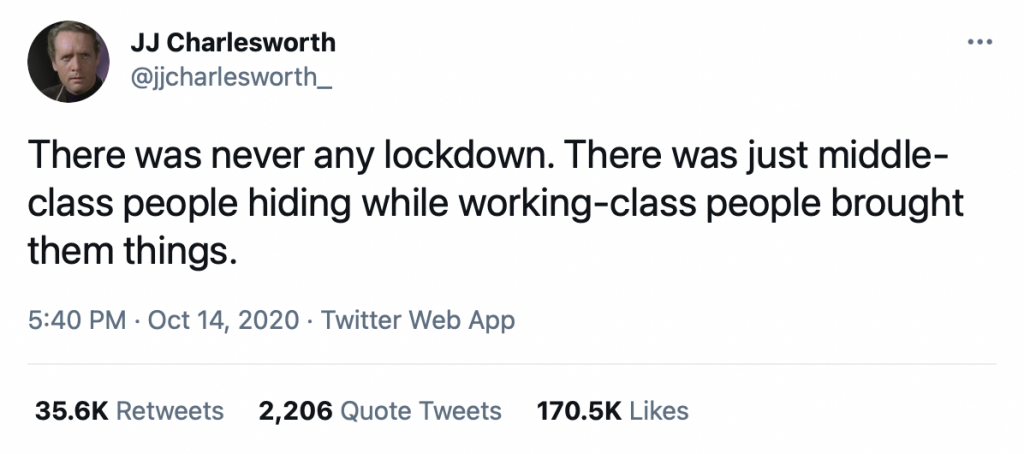
Did Lockdown Shift the Burden of COVID-19 Onto the Working Class?
LOCKDOWN SCEPTICS
One of the claims put forward by the authors of The Great Barrington Declaration is that lockdowns unfairly shifted the burden of COVID-19 onto the working class. As Martin Kulldorff and Sunetra Gupta argue in a piece for the Toronto Sun last November:
Low-risk college students and young professionals are protected; such as lawyers, government employees, journalists, and scientists who can work from home; while older high-risk working-class people must work, risking their lives generating the population immunity that will eventually help protect everyone.
The same idea was captured in a viral tweet by the art critic J.J. Charlesworth:

To evaluate this claim, let’s begin by looking at some of the data from Britain. Last July, the ONS attempted to quantify the extent to which different jobs can be done from home. Unsurprisingly, they found that higher-paying jobs in the professional and managerial classes are much easier to do from home, whereas lower-paying jobs in the skilled and unskilled working classes are much harder to do from home. (‘Front-line doctor’ is an exception.)
While “key workers” are drawn from all income deciles, a relatively large percentage are drawn from the 2nd, 3rd and 4th deciles – particularly in the food and necessary goods sector. And according to the ONS, 15% of such workers were at an increased risk of COVID-19 because of a pre-existing health condition.
In January of 2021, the ONS computed age-standardised mortality rates for COVID-19 in different occupations. They found that men in professional and managerial occupations were substantially less likely to die of COVID-19 than those in service and elementary occupations:

The pattern among women was similar, although somewhat less pronounced. (The highest age-standardised mortality rate was for women working as plant or machine operators.)
In a study published in Nature, Elizabeth Williamson and colleagues analysed data on a large sample of British adults, and found that individuals from the bottom quintile for area deprivation were significantly more likely to die of COVID-19, even after controlling for age, sex, ethnicity and a number of pre-existing health conditions. This may be because such individuals had greater exposure to the virus, although there are other possible explanations.
It’s important to note that men in elementary occupations and skilled trades are more likely to die for any reason than men in professional and managerial occupations. In other words, there is a mortality gradient across occupations for all-cause mortality, as well as for COVID-19. This means that the two gradients may be partly caused by the same factors – such as more men in working class occupations having pre-existing health conditions.
Furthermore, the fact that people in working class occupations were more likely to die of COVID-19 does not, by itself, prove that lockdown shifted the burden of COVID-19 onto the working class. Such people might have been more likely to die of COVID-19 even in the absence of lockdown – say, because they were less able to engage in voluntary social-distancing.
In order to evaluate the claim that lockdown shifted the burden of COVID-19 onto the working class, we need to compare countries or states that did lock down with those that did not. Of course, the only major country in Western Europe that did not lockdown is Sweden.
In an unpublished paper, Sunnee Billingsley and colleagues analysed Swedish data, and found that workers in frontline occupations were not more likely to die of COVID-19 when adjusting for individual characteristics. Their findings indicate “no strong inequalities according to these occupational differences in Sweden and potentially other contexts that use a similar approach to managing COVID-19.” This supports the Great Barrington Declaration authors’ claim.
Another way of testing the claim that lockdown shifted the burden of COVID-19 onto the working class is by comparing infection rates across social classes before and after lockdown.
In a study published in BMC Public Health, Nathalie Bajos and colleagues analysed French data, and found that individuals in the highest social class saw a substantial decline in the risk of infection after the country went into lockdown, whereas individuals in the lowest social class saw a much smaller decline. Though it’s possible these differences emerged due to voluntary changes in behaviour that happened to coincide with the start of the lockdown.
Overall, there is tentative evidence that lockdown did shift the burden of COVID-19 onto the working class. However, comparative studies will be needed to investigate this claim more systematically.
Source

••••
The Liberty Beacon Project is now expanding at a near exponential rate, and for this we are grateful and excited! But we must also be practical. For 7 years we have not asked for any donations, and have built this project with our own funds as we grew. We are now experiencing ever increasing growing pains due to the large number of websites and projects we represent. So we have just installed donation buttons on our websites and ask that you consider this when you visit them. Nothing is too small. We thank you for all your support and your considerations … (TLB)
••••
Comment Policy: As a privately owned web site, we reserve the right to remove comments that contain spam, advertising, vulgarity, threats of violence, racism, or personal/abusive attacks on other users. This also applies to trolling, the use of more than one alias, or just intentional mischief. Enforcement of this policy is at the discretion of this websites administrators. Repeat offenders may be blocked or permanently banned without prior warning.
••••
Disclaimer: TLB websites contain copyrighted material the use of which has not always been specifically authorized by the copyright owner. We are making such material available to our readers under the provisions of “fair use” in an effort to advance a better understanding of political, health, economic and social issues. The material on this site is distributed without profit to those who have expressed a prior interest in receiving it for research and educational purposes. If you wish to use copyrighted material for purposes other than “fair use” you must request permission from the copyright owner.
••••
Disclaimer: The information and opinions shared are for informational purposes only including, but not limited to, text, graphics, images and other material are not intended as medical advice or instruction. Nothing mentioned is intended to be a substitute for professional medical advice, diagnosis or treatment.




